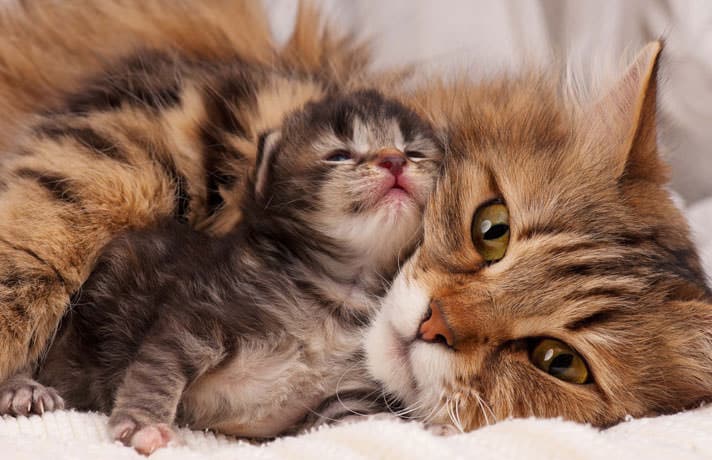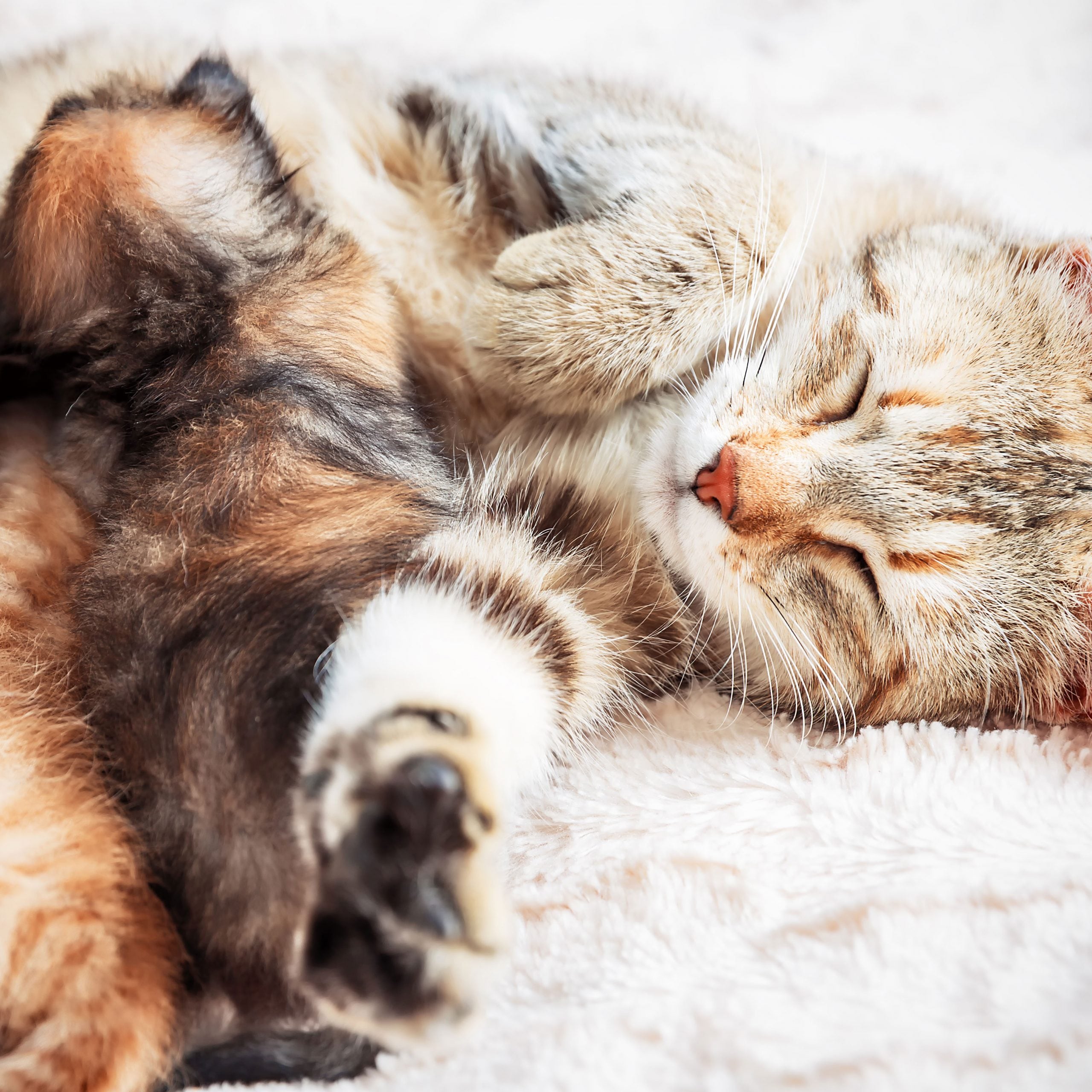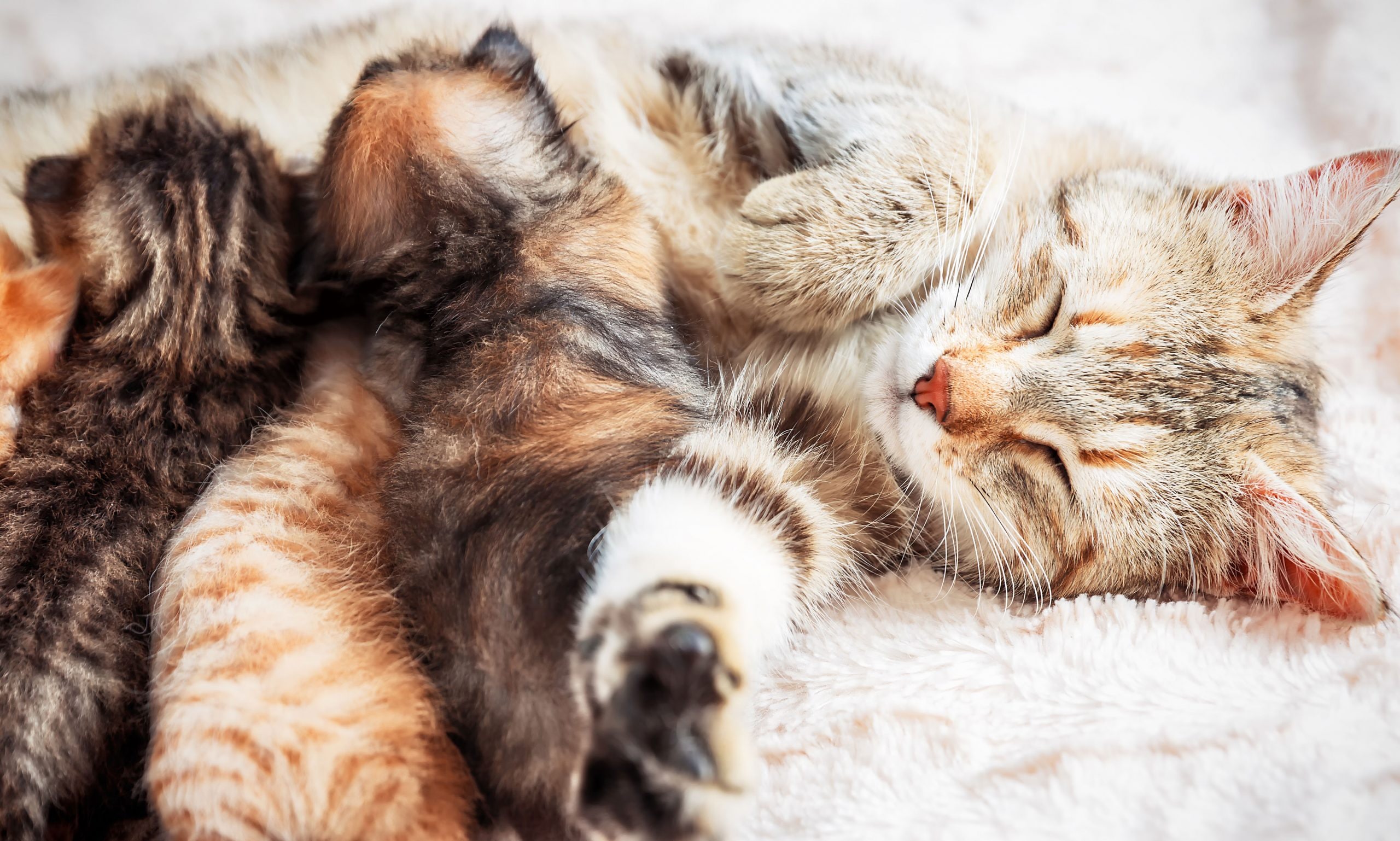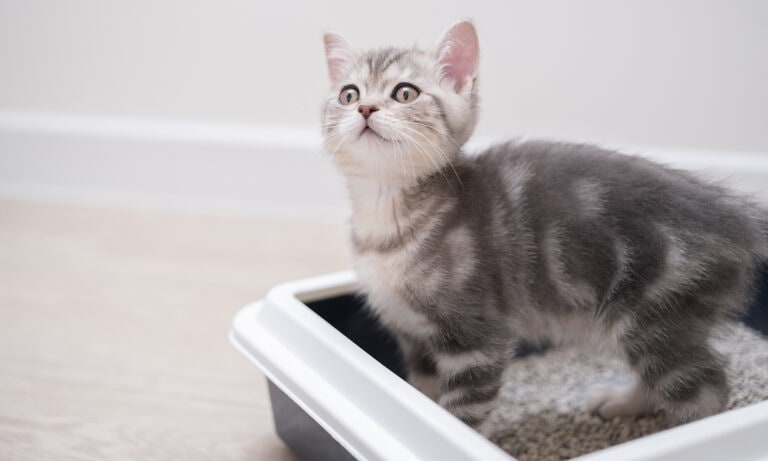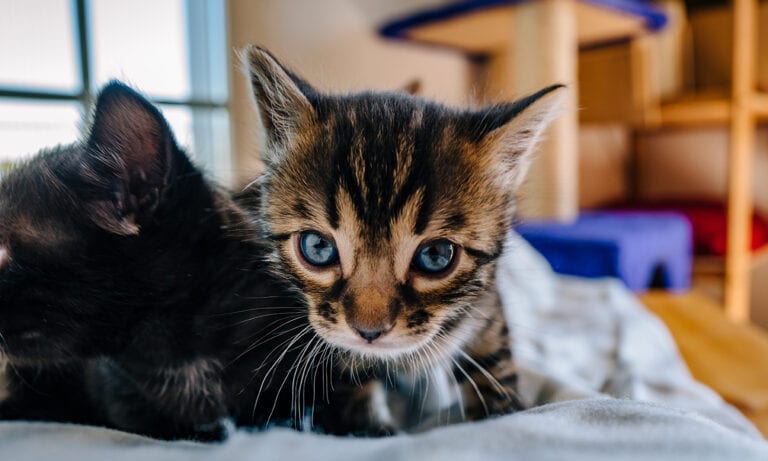Fading Kitten Syndrome (FKS) refers to the death of a newborn kitten between birth and weaning (approximately 4 to 5 weeks of age—the age when kittens are most vulnerable to hypothermia, hypoglycemia, dehydration and infection), and it is often caused by hypothermia (low body temperature) and/or hypoglycemia (low blood sugar).
Once signs of FKS are identified, the kitten should be seen as soon as possible at the clinic. Some kittens are born with congenital issues that may ultimately shorten their lives.
Knowing the approximate age and normal milestones for kittens can help you identify signs of potential problems. Ahead, we’ll go over the symptoms of FKS, the possible causes and more.
Click to jump to each section:
Symptoms of Fading Kitten Syndrome
Healthy kittens are warm and have some fleshy padding over their bony points, whereas a kitten may be sick if she feels cold in the presence of sufficient environmental warming or feels bony.
Sick kittens may also exhibit symptoms of:
- Excessive crying, even after feeding or may just not nurse well. Healthy kittens nurse almost immediately after birth, while a fading kitten may have a poor suckling reflex.
- Separating themselves from the rest of the litter
- Seeming limp or weak when picked up.
- Unpleasant odor not related to normal urine or feces, if infection is present
Any vomiting or diarrhea should be considered life threatening and requires immediate veterinary care. Diarrhea is present in about 60 percent of sick kittens and may cause excessive fluid losses and weakness.
Other warning signs that indicate immediate medical attention is needed for a kitten include:
- Abdominal distension
- Gray, pale or yellow mucous membranes
- Nasal or eye discharge
- Sneezing
- Labored breathing
- Thin body condition
Some congenital malformations may be easily seen and others may not. These physical anomalies may predispose the kitten to a shortened life, depending on location and the severity.
Watch For These Kitten Milestones
You can use the following milestones to help place the age of a kitten if the birth date is unknown:
- By 3 days of age, kittens should be able to right themselves if placed on their backs. Failure to do so could indicate abnormal weakness.
- By 2 weeks of age, normal kittens should be able to support themselves on all four limbs as they crawl and begin a limited exploration of their environment.
- Around 5 to 14 days, their eyes generally start to open.
- About 6 to 17 days after birth, ear canals begin to open up.
Possible Causes of Fading Kitten Syndrome
It’s Mom’s Fault
A mother cat is called a queen. Her breed, age, health, nutritional status, disposition and blood type all may dictate the risk for Fading Kitten Syndrome in her babies.
- Age: Studies have shown that very young mother cats experiencing their first litter are at risk for higher kitten mortality rates. Many of these young cats may have a difficult time birthing or provide poor mothering. On the other hand, older mother cats have been observed to have an increased risk for offspring with congenital defects.
- Dystocia: Difficulty during birthing is called dystocia and is one of the most common causes of injury to both the mother and her kittens. I have personally seen a mother cat experiencing dystocia and pain turn around and bite the kitten during the birthing process. Fortunately, the injury for this kitten was minor, and I was able to tend to the wound immediately. In an unsupervised situation, bacteria, flies, ants and predators can be attracted to a wound and lead to disaster.
- Litter size: In general, the number of kittens in a litter can also influence mortality outcomes. Significant stress, overcrowding or nutritional deficiencies in the mother can all lead to problems for the kittens.
- Lack of milk: While not common, a mother cat may experience a lack of adequate milk production, which leads to hungry and restless kittens. Supplemental bottle-feeding with a suitable milk replacement formula may be needed while waiting to see if the mother cat can increase her milk production.
- Neonatal isoerythrolysis (NI): Neonatal isoerythrolysis is a condition that can cause Fading Kitten Syndrome due to a compatibility issue between a mother cat and her kitten’s blood type. NI occurs when a mother cat and her kittens do not share the same blood type. Cats have three blood types labeled A, B and AB. Blood type A is dominant and AB is rare. Type B cats have high levels of antibodies against type A red cells, but type A mothers typically have low levels of antibodies directed against type B red cells. NI occurs when a type A or type AB kitten is born to a type B mother. When the kittens consume the mother’s colostrum (the first milk) containing the mother’s antibodies, the kittens’ red blood cells undergo destruction from these antibodies. As the mother’s anti-A antibodies destroy her babies’ red cells the kittens becomes anemic, and this anemia can lead to FKS.
- Breed: A number of purebred cats, including Persian, Devon Rex, Himalayan, Birman, Somali, Abyssinian and British Shorthair, have known or high incidence of type B blood. Knowing the blood type of both parents can help predict the blood type of the kittens. If incompatibility is suspected, NI can be avoided by preventing the kittens from ingesting the colostrum of their mother. To provide some immunity to these babies, serum from a blood type A adult cat must be administered to the kittens. Talking to your veterinarian before the birth is the best way to plan for this.
Runt of the Litter
In kittens, an average normal birth weight is considered approximately 90 to 100 grams, with a steady gain in weight of 10 to 15 grams per day.
Healthy kittens usually double their birth weight by 1 to 2 weeks of age.
Kittens with low birth weights, often called runts, may have congenital abnormalities, immature lung development and decreased nursing ability.
Not all “runts” are destined for a poor prognosis, however. Depending on the individual’s condition, with close monitoring and veterinary care these smaller, weaker kittens may get back on track for normal growth.
It’s in the DNA
Congenital disorders are abnormalities that are present at birth. It is estimated that congenital abnormalities account for 10 to 20 percent of all neonatal kitten deaths. Some studies have shown that purebred cats have a kitten mortality estimated at 34 percent in the first year of life compared to 10 to 17 percent in non-pedigreed cats. Responsible breeding by knowledgeable cat breeders can significantly lower these risks. This means not breeding cats with certain health issues and reducing inbreeding when choosing parent cats.
Congenital abnormalities may cause kittens to be stillborn or have physical defects, such as atresia ani (absence of anal opening), cleft palate, redundant body parts (faces and limbs being most common) or heart defects. Kittens with these conditions should be evaluated by a veterinarian to look for a surgical cure or to determine the most humane plan of action.
Infectious Diseases
Infectious or contagious causes of Fading Kitten Syndrome can include bacterial, viral, protozoal and external or internal parasites.
Bacterial infections can occur in the respiratory and gastrointestinal tract, at the umbilical cord or in wounds.
Viral infections may be transferred from an infected mother cat or other adult cats nearby. Some viruses and internal parasites can be transferred via the placenta and milk, while external parasites, like fleas or ticks, can come from the environment.
Colostrum is the first milk that kittens need to consume during the first 18 hours of life to obtain their mother’s protective antibodies. These antibodies protect against common bacteria and viruses that the mother has been exposed to. In cats there is little to no transplacental transfer of antibodies, unlike in humans. Protective antibodies consumed from the mother’s colostrum start to decrease in the kittens at approximately 3 to 4 weeks of age, making this stage the most vulnerable for mortality in kittens due to infection. Healthy kittens start to make their own antibodies at 5 to 6 weeks of age.
Kittens affected by bacterial infection can receive medications for cat flea treatment.
Environmental Causes
Even healthy kittens are at risk for illness or death if not kept in the proper environment or nursery (if they are orphaned).
- During the first week of life, newborn kittens are poikilothermic, meaning their body temperatures vary with the environmental temperature. At birth, a normal body temperature is approximately 95 to 98 degrees Fahrenheit.
- During the second and third weeks of life normal body temperatures rise to 97 to 100 degrees.
- By 4 weeks of age body temperatures are about that of adults, around 100 to 102 degrees.
Hypothermia can be both a cause and a sign of fading kittens. Low body temperatures result in a decreased heart rate with poor circulation. Hypothermic kittens do not nurse well and are unable to digest cat food because of slow intestinal movement. However, temperatures that are too high can lead to restless crying, panting or death.
Toxins
Exposure to toxins in the environment can potentially also lead to Fading Kitten Syndrome.
Toxins in the bedding of the nursery box can be absorbed more readily through the thin skin of newborns. Wood shavings, oils or residue from disinfecting cleansers in the bedding material can enter the respiratory tract or skin and cause irritation or poisoning.
One guideline to avoid toxin exposure is not to use wood shavings or materials with an odor.
Nutritional Causes
Another significant cause of Fading Kitten Syndrome is malnutrition.
If bottle-fed kittens receive an inadequate milk replacement formula or spoiled milk, it can lead to tragedy. If a mother cat has poor caloric intake and is nursing kittens, her milk quality and quantity may be compromised.
Hypoglycemia or low blood sugar is a common problem for the very young kittens, especially if already sick.
Neonates (kittens within the first 4 weeks of life) are susceptible due to immature liver function and rapid depletion of glycogen (a form of sugar) stores. Hypoglycemia and dehydration can also occur when vomiting or diarrhea is present. Neonatal kittens have poor fluid compensatory mechanisms and immature kidney function, thus making them at higher risk for dehydration.
Evaluating hydration can be challenging in young kittens, as skin elasticity is not always a reliable marker. In properly hydrated kittens, mucous membranes should be moist and either a light red or pink.
The kitten should also be producing urine and feces after every feeding.
Maintaining proper nursery humidity of around 55 to 65 percent can also help reduce additional excess fluid losses and decrease risks for dehydration.
Kitten Fading Syndrome Treatment Options
Follow the Fading Kitten Protocol, according to the Best Friends Animal Society:
- Contact your vet or, for those with foster kittens, your shelter or local rescue group.
- Apply supplemental warming. Apply a heating pad on low or warming disc, with a blanket separating the heat source from the kitten.
- Apply dextrose or karo syrup to kitten’s gums or under their tongue, and apply every few minutes until vet evaluation.
Other ways pet parents or foster parents can help a kitten with Fading Kitten Syndrome is by ensuring proper sanitary conditions and appropriate environmental temperatures. Monitor their nursing behavior closely, and monitor for appropriate weight gain.
More about caring for kittens:
Share:
